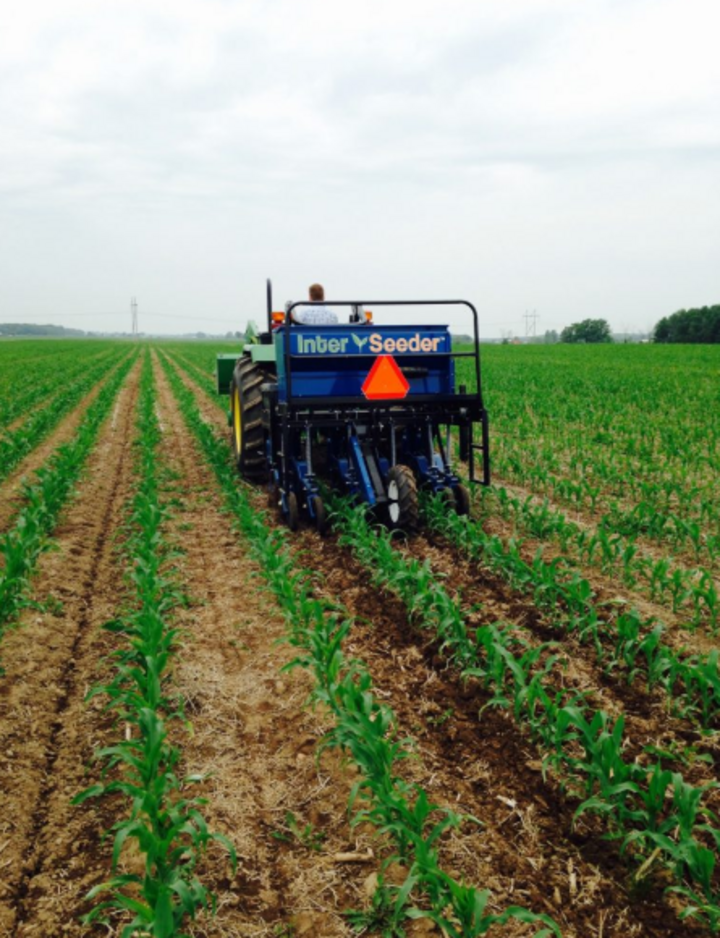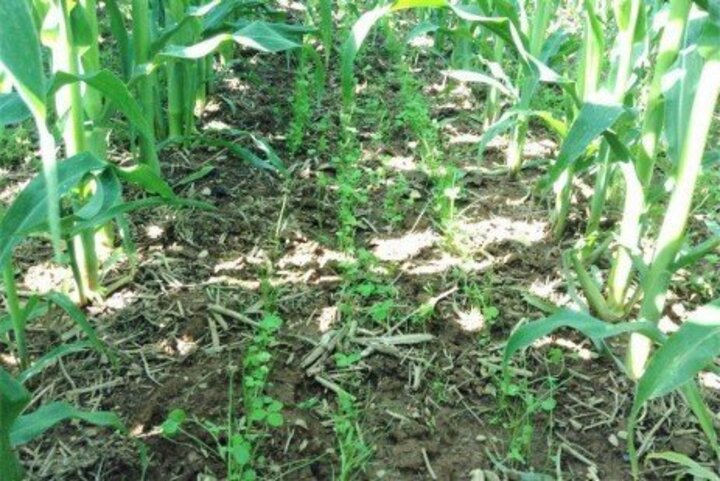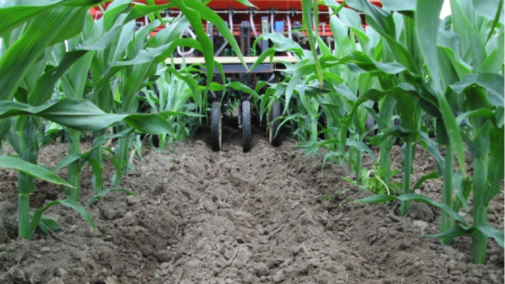An increasing number of growers are integrating cover crops into their cropping systems with goals of reducing erosion, increasing soil health properties, adding/capturing nitrogen, grazing livestock, or aiding in weed suppression. Cover crop establishment after corn and soybean harvest can be challenging with mixed results. Thus, an increasing number of growers have asked about the potential for interseeding cover crops (Figure 1) into an established crop.


Interseeding is primarily done prior to crop canopy closure or prior to harvest when the crop canopy begins to re-open. After the crop harvest, the hope is the cover produces greater biomass since it’s already established compared to if it were seeded post-harvest. This article shares the research on interseeding, considerations for interseeding, and an on-farm research protocol for obtaining more cover crop interseeding data in Nebraska.
Key Points
- Most studies show minimal corn yield impact with interseeding cover crops during the V5-V7 growth stages. Few studies exist with interseeding into soybean.
- Research consistently shows that rimsulfuron (Resolve, Basis) and safluenacil (Sharpen) tend to result in little to no herbicide injury on interseeded grasses, legumes, brassicas, or mixes. Penn State University lists additional herbicide injury ratings.
- Most successful legume options include clovers such as red, crimson, berseem, and balansa. Cereal rye and annual ryegrass are the most common grasses interseeded. Buckwheat and phacelia were used in organic studies to attract beneficial insects.
- Many types of equipment have been retrofitted/purchased to interseed cover crops (Figure 2).
- Have your plans together a few growth stages before you actually interseed. From grower conversations, once the crop takes off, it is hard to catch up if interseeding plans aren’t already in place. If you hope to interseed by V5-V8, have your seed and interseeder ready by V3 so you can actually get the cover crop interseeded at V5-V8 when the weather allows. The window is narrow and closes quickly.
- Regarding crop insurance, the USDA Risk Management Agency (RMA) addresses interseeding in its cover crop guidelines. In a Q&A with the guidelines, it noted that coverage of an insured grain crop would not be affected by “seeding a cover crop into an existing crop (e.g., corn or soybeans) at a time that will not impact the yield or harvest of the insured crop. These examples do not affect the insurability of the insured crop, but if not done properly, may impact the indemnity received in the event of a loss on the insured crop.” Please contact your crop insurance agent with any questions.
Nebraska Research
Angela Bastidas investigated interseeding in her Ph.D. work at UNL, broadcasting cover crops into corn- simulating aerial seeding (Bastidas, 2017). She interseeded several cover crop species [60 lb/ac rye; 20 lb/ac hairy vetch; 40 lb/ac soybean MG VIII; 10 lb/ac radish; and a 38 lb/ac mixture of rye , hairy vetch, and radish (30, 5, and 3 lbs, respectively.)] at the time of corn planting as well as at the V8 stage. The later seeding date had no effect on corn yields but produced very little cover crop biomass. However, the interseeding at planting reduced yields by up to 160 bushels per acre. As summer cover crop and weed biomass increased with the interseeding at corn planting, corn yields decreased.
In a 2018 on-farm research and NRCS demonstration study, farmers in Merrick County compared a fall dormant seeding versus fall dormant seeding + spring interseeding versus a check. In the fall of 2017, both the dormant-seeded treatment strips and the dormant + interseeded treatment strips had a cover crop mix. The cover crop mix in both treatments was terminated with glyphosate on May 10, 2018. Corn was planted on May 17 followed by a post application of 32 oz glyphosate + 5 oz Status per acre on June 1. They used a Hiniker interseeder to plant the cover crop mix on June 26 which included 6 lb/ac cowpea, 6 lb/ac soybean, 0.5 lb/ac crimson clover, 5 lb/ac sunhemp, 2 lb/ac hairy vetch, 3 lb/ac buckwheat, 0.5 lb/ac chicory, 0.5 lb/ac flax, 0.5 lb/ac rapeseed/canola, 6 lb/ac Elbon cereal rye, 6 lb/ac spring oats. There were no differences in corn yield with any treatments; no biomass measurements were reported in the study.
In a 2017 on-farm research study, a Dawson County farmer compared planting various cover crops at the same time as planting corn in an organic system. Treatments included: 12 lb/ac soybean; 2 lb/ac clover; a 5 lb/ac mixture of phacelia, lentils, and turnips; twin-row corn; and a check of monoculture corn. There were no yield differences among treatments; no biomass measurements were reported in the study.
Research from Other States
Researchers at Penn State have conducted numerous studies on interseeding cover crops and have even commercialized an interseeder. This FactSheet provides a summary of their research and their recommendations on the timing of interseeding into V5 corn, herbicide use, and cover crop species to use.
Researchers at the University of Wisconsin seeded radish, red clover, and winter rye into V5 corn (Figure 3). The covers had good growth up to grain harvest. Biomass of the cover crop species varied after harvest due to being covered by the corn residue. The rye was the only crop that needed to be terminated the following spring. There was no corn yield reduction and no visible stress to the corn in the two years of their study. This FactSheet summarizes findings from the University of Wisconsin trials.
Researchers at Michigan State compared interseeding annual ryegrass, crimson clover, and tillage radish into corn from the V1 to V6 growth stages. They found the greatest weed pressure with the interseeding at V1 which decreased with each successive interseeding stage. Corn yield was reduced by the V1 interseeding timing but not the others. Interseeding at V4-V5 corn development resulted in the greatest cover crop biomass in October.
An Ohio State University researcher compared a monoculture corn crop to corn interseeded with individual species treatments of radish, annual ryegrass, and red clover. The cover crop species were interseeded using a high clearance drill and also via broadcast seeding at V6. Cover crop establishment was considered similar with both methods. There were no yield differences among the treatments. Biomass of red clover and radish after grain harvest was higher than annual ryegrass and the biomass of the red clover the subsequent spring was higher than the annual ryegrass.
In a 2017 on-farm research study in Ohio 13 lbs/ac annual ryegrass versus 30 lbs/ac cereal rye interseeded into V6 corn were compared to a check treatment. Both grass cover crops had 4-6 inches of growth at the time of corn harvest. There were no corn yield differences among the treatments.
Thirteen lb/ac annual ryegrass, 30 lb/ac cereal rye, and 27 lb/ac oats were interseeded at soybean development stages R3, R5, and R7 in twin-row soybean in a 2017 on-farm research study conducted in Ohio. The soybean interseeded with the oats at R5, and soybean interseeded with cereal rye and annual ryegrass at R7 yielded significantly less than the check (no interseeded cover crops).
Testing via On-Farm Research
Our hope is to obtain more research data from Nebraska. If you are interested in testing interseeding via on-farm research, the following two-treatment and three-treatment protocols can be found at: https://go.unl.edu/kvjf. The two-treatment protocol compares interseeding versus a check.
The three-treatment protocol can be altered a number of ways including:
- Interseeded species/mix 1 versus interseeded species/mix 2 versus check
- Broadcast interseeded versus drilled interseeded versus check
- Timing 1 versus timing 2 versus check
Please contact your local on-farm research Extension educator or one of the authors if you’re interested in trying this!
References
2016 Cover Crops Crop Insurance, Cover Crops and NRCS Cover Crop Termination Guidelines. Aug. 3, 2016. USDA Risk Management Agency.
Bastidas, Angela. 2017. Cover crop introduction into corn (Zea mays L.) – soybean (Glycine max L.) cropping systems. Ph.D. dissertation, University of Nebraska.
Brooker, A., K. Renner, C. Sprague, and L. Tiemann. Nov. 8, 2016. Interseeding Cover Crops in Michigan Corn Rotations. Poster presented at American Society of Agronomy.
Clevenger, Wm.B. Interseeding Cover Crops into Growing Corn. Ohio State University Extension.
Clevenger, Wm.B. Interseeding Cover Crops into Twin Row Soybean. Ohio State University Extension.
Curran, W. and G. Roth. Oct. 9, 2017. Cover Crop Interseeder: Improving the Success in Corn. Penn State University.
Haden, V.R. Nov. 8, 2016. A Performance Evaluation of Three Cover Crop Species Interseeded into Continuous Corn Via High Clearance Drill and Broadcast Seeding Methods. Poster presented at American Society of Agronomy.
Smith, D. and M. Ruark. May 25, 2017. Considerations For 2017 Cover Crop Interseeding. University of Wisconsin.
Thompson, L. et al. 2018. Effect of Interseeding Cover Crops at Planting on Organic Corn. 2017 Nebraska On-Farm Research Results.
Thompson, L. et al. 2019. Corn Planted Following Dormant and Interseeded Cover Crop, Dormant Seeded Cover Crop, and No Cover Crop Check. 2018 Nebraska On-Farm Research Results.

